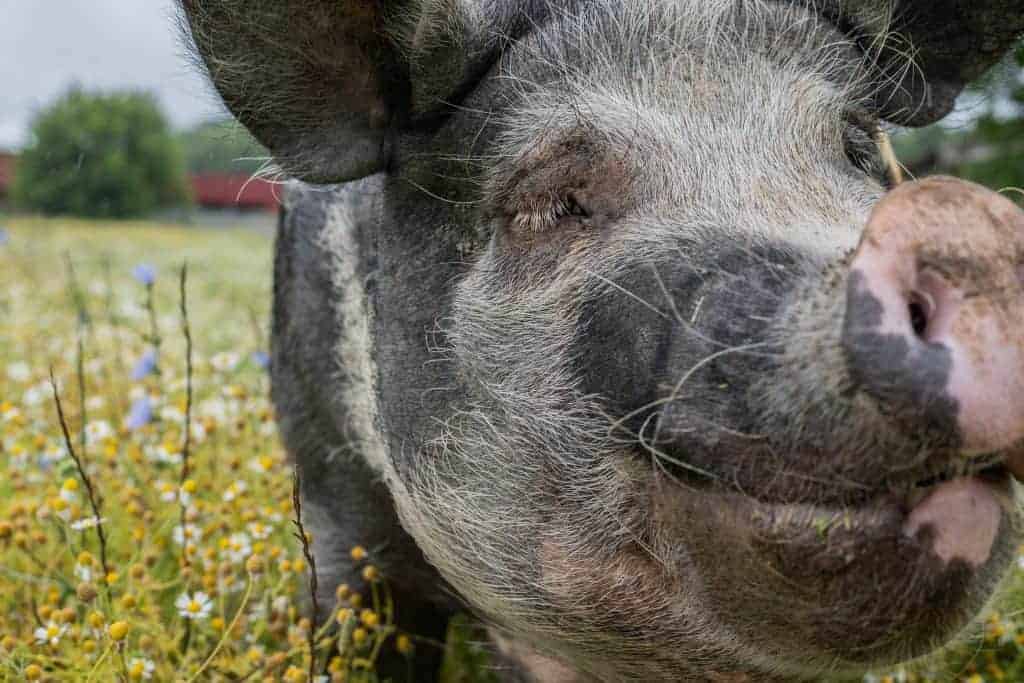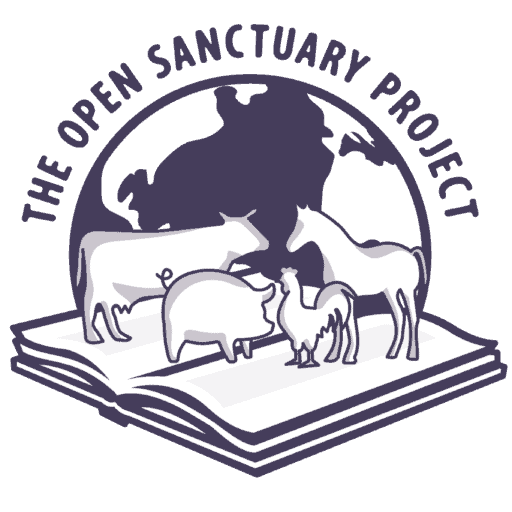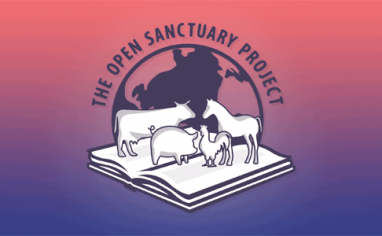
This resource has been fully reviewed and updatedA member of The Open Sanctuary Project’s staff has given this resource a full review and provided updates where necessary. by a member of The Open Sanctuary Project team as of April 4, 2025. It was originally published under a different name on December 7, 2018.
If you plan to welcome a pig resident to your sanctuary or into your life, it’s important to familiarize yourself with the care they require. Ideally, you should learn as much as you can before you take on the responsibility of their care, but we realize life doesn’t always go according to plan. We offer numerous resources dedicated to the topic of pig care, as well as additional resources focused on general animal care topics that can help you begin to learn more about how to responsibly care for pigs. With so many offerings on our website, we know it can be tricky to figure out where exactly to start, so this resource serves as an introduction to pig care, providing an overview of important topics and directing you to additional resources for more information.
Background
To best care for pigs, it’s important to understand who pigs are and where they came from. Pigs belong to the scientific genus known as Suidae, a group of hoofed mammals commonly referred to as pigs, hogs, or boars, who appeared on Earth sometime between 20-35 million years ago! Depending on the source, it’s believed there are between 14 to 19 distinct species of suids that exist today. One of those is the wild boar (Sus scrofa), who is the living wild ancestor of the modern domesticatedAdapted over time (as by selective breeding) from a wild or natural state to life in close association with and to the benefit of humans pig (Sus scrofa domesticus). While domesticated pigs may look quite a bit different from their wild ancestors, they continue to share many similarities with wild boars, particularly in terms of their natural behaviors. To learn more about wild boars, how pigs came to be domesticated, and some of the challenges domesticated pigs face, check out our resource here.
Diet
The compassionate lifelong care of pigs at animal sanctuaries starts with the food they’re provided. Obesity and obesity-related health issues are common and serious issues that can affect any pig, but are especially common in large breedDomesticated animal breeds that have been selectively bred by humans to grow as large as possible, as quickly as possible, to the detriment of their health. pigs and potbellied pigs. To help pig residents maintain a healthy weight and reduce their risk of several health challenges, it’s crucial to provide them with an appropriate diet. For healthy, mature pig residents, this should consist of a complete diet pig food (i.e., “pig pellets”), as well as forage and supplemental produce. Because of their love of eating and their propensity for weight gain, pig residents must have their portions managed to keep them at a healthy weight.
Piglets Have Unique Care Needs!
Piglets have very different needs when it comes to things like nutrition, housing, and general care. You can read more about caring for piglets here.
Compared to other species, pigs are particularly vulnerable to developing salt poisoning, which is the most common form of poisoning in pigs and is usually caused by water deprivation. Pigs are also known to rearrange things with their strong snout. If their water vessel is not secured, this normal behavior could result in their drinking water being spilled, leaving them without a source of water. While we recommend having systems in place to check water sources frequently throughout the day for all species, this is particularly important for pig residents.
You can read more about providing a healthy diet to pigs here.
Living Spaces
Pigs need an indoor shelter to keep them safe and comfortable, as well as ample outdoor space in which to roam, root, and socialize. When designing resident living spaces, caregivers must make sure the spaces meet the basic needs of both the residents and the human caregivers, but we also encourage them to take an animal-centered design approach, which entails thinking about what the residents need to thrive and what type of space they would design for themselves if they could. You can read more about animal-centered design here.
Indoor living spaces for pigs must provide enough space and proper traction for pig residents to move around comfortably and safely. The space must protect residents from the elements year-round and be set up so that you can maintain it at a safe and comfortable temperature while still providing proper ventilation. Given how common foot and joint issues are, flooring must be easy on the feet and joints.
Outdoor living spaces must provide residents with enough space and opportunities to perform natural behaviors (such as rooting) and must be enclosed by appropriate fencing. During warm weather, outdoor spaces should include ample opportunities for residents to cool off and get out of the sun. To learn more about creating living spaces for pig residents, check out our resource here.
Providing appropriate living spaces is just one part of the equation. You also need to keep it clean and properly maintained to ensure their continued comfort, safety, and health! You can read more about how to do this here.
Social Needs
Pigs are social animals who enjoy spending time with their pig friends and sharing a fluffy nest with their companions (though some house pigs might be quite content being the only pig in the household so long as they get lots of interaction with their human companions). While we generally recommend that pig residents should have the opportunity to live with other pigs when possible, it’s important to understand that social dynamics with pigs can sometimes be a bit complicated. Introductions between pigs who do not know each other (and re-introductions between pigs who have been separated from each other) must be done thoughtfully. You can read more about conducting pig introductions here. If you are considering introducing a pig resident to a member of a different species, this too must be done with careful thought. You can read more about this topic here.
Enrichment
It is easy to think that food, water, shelter, and veterinary care make up all of a resident’s basic needs, but enrichment is also an important aspect of basic care. It can be difficult to think of enrichment if you have many residents to care for or an endless list of tasks to finish, but enrichment can completely change the mental, emotional, and physical lives of residents for the better! You can read more about why enrichment is so important here, and you can find pig-specific enrichment ideas here. These are just two of the many enrichment resources we offer, so be sure to browse our other offerings as well!
Health Care
A critical component of animal care consists of establishing practices and protocols that help keep residents healthy. Below, we’ll highlight some important health care practices for pig residents.
Veterinary Care
Regardless of the species you care for, you must establish a relationship with a veterinarian who is comfortable working with that species and is experienced in their care. When it comes to pigs specifically, this can sometimes be challenging. You can read a bit more about this topic, as well as how to find appropriate veterinary care for your residents, here. Of particular note, it’s important to find a veterinarian who is able to spay and neuter pigs and one who is comfortable euthanizing pigs using gentle, non-physical methods similar to what you would expect for a beloved cat or dog. To learn more about why spaying and neutering pigs is so important and what these procedures entail, check out our resource here. For more information about the challenges that may arise when trying to find a veterinarian who is comfortable euthanizing pigs in a way that is aligned with compassionate care, you can read our resource here.
In addition to these aspects of care, your veterinarian will play a crucial role in providing care to residents who are injured or ill, and if residents require treatments, they can properly train you to administer them. Your veterinarian can also assist you in establishing appropriate care practices for your residents that are tailored to their specific needs, which may include helping your sanctuary establish a biosecurity plan, intake procedures, parasite screening strategies (such as routine fecal testing), and a vaccination program for your pig residents. As residents grow old, they can also make specific recommendations to address their changing needs and any health challenges they face.
Daily Observation
While your veterinarian plays an essential role in your pig residents’ health care, it’s also important to familiarize yourself with signs of health and signs of concern in pigs so you can closely observe your residents for potential issues. This will increase the chances of catching and addressing health issues early. To learn more about using daily observation to monitor your residents’ health and well-being, check out our resource here.
Routine Health Checks
In addition to regular veterinary care and daily observation, it’s important to perform routine health checks on your residents. By thoroughly checking each resident regularly, you’ll learn what’s normal for them and will be better able to catch health concerns early. We recommend performing pig health checks every 6-8 weeks. You can read more about what this entails here.
Hoof Care
Hoof care is an essential aspect of pig care. Some caregivers provide any necessary hoof care (such as trimming or addressing hoof cracks) during routine health checks, but others prefer to have this done separately and may choose to work with a farrierSomeone who provides hoof trimming and care, especially for horses or cows rather than trimming hooves themselves. However you accomplish it is fine so long as their hooves are checked regularly, are kept at a healthy length, and any issues are addressed quickly. Without proper hoof care, pigs can develop various conditions that can affect their quality of life and could predispose them to other more serious issues. Overgrown hooves can cause hyperextension of the joints of the leg, which can result in lameness and damage to joints. Hoof cracks can occur even in properly trimmed hooves, but are especially common when hooves are overgrown. Cracks in hooves allow pathogens to enter and can lead to infection. Close observation and regular evaluation of hooves is imperative to ensure issues are addressed before they become more serious. To learn more about hoof care for pigs, check out our resource here.
Skin Care
Compared to other farmed animal sanctuaryAn animal sanctuary that primarily cares for rescued animals that were farmed by humans. residents, pigs tend to need more attention paid to their skin. Some breeds are prone to dry skin and may benefit from dietary changes and/or topical treatments to help moisturize the skin. Be sure to talk to your veterinarian about what they recommend, and have them assess the individual to make sure there is not a more serious issue causing the individual’s dry skin.
Light-skinned pigs are very prone to sunburns, which are not only painful but also increase their risk of developing non-melanoma skin cancer, so it’s important to offer your residents proper sun protection, which you can read more about here. Sunburns can be managed with a pig-safe soothing ointment, but be sure to avoid anything that contains alcohol, as this will sting.
Human Safety Considerations
Caring for pig residents means you’ll need to enter their living spaces and be in close proximity to residents. Not only will you need to interact with residents while providing necessary care, but you’ll also want to interact with them to build trust and establish a positive relationship with them. However, to interact with pig residents (or any resident) safely, it’s important to recognize when they are telling you they need space and when they welcome your presence. Not only will this help keep humans safe, but it will also help you avoid unnecessarily stressing out or agitating your residents. Because there may be times when it is necessary to gently restrain a pig resident (for example, to have them evaluated by a veterinarian or to have their hooves trimmed), it’s important to learn how to do this safely. You can read more about these topics here.
Recordkeeping
With all of the very important aspects of pig care, it can be easy to think of recordkeeping as being less of a priority, and when things are busy (which may be all the time!), recordkeeping may be the first thing to slip. However, consistently maintained records kept in a safe, well-organized location are critical for resident health and safety, as well as the safety and success of your sanctuary. Documenting resident health histories can help inform decisions for each individual and can also be used to benefit others. To learn more about the many benefits of regular health documentation, check out our resource here. You can also read about different record-keeping systems here.
While this resource just provides a brief overview of important pig care topics, hopefully it has given you a better idea of the care they require! Be sure to check out the links throughout this resource to learn more about caring for pigs and providing them with the best life possible!








